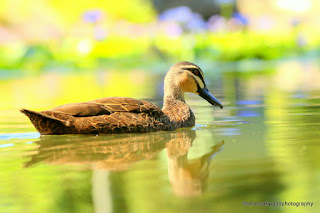Cotton Pygmy Geese
Despite its name, the cotton pygmy goose is actually a small, surface-feeding duck. This bird has a goose-like bill and a white head, neck and underbelly. It is dark glossy green on top and has a narrow breast band. Females have a duller plumage, a dark eye-line stripe and white eyebrows. During the breeding season, males have a black band around the neck base.
The cotton pygmy goose uses large hollows in trees close to the water for nesting. Nests can be lined with grass, rubbish and feathers and clutch sizes range from 6 to 12 eggs. Nesting occurs between November and April. The female incubates and rears the ducklings with some support from the male. Males stay with the female and ducklings for a fortnight, while the female will stay for six months. This species has limited territorial displays, often co-existing peacefully with other nesting pairs in the same area.
Where are they found?
In Australia, the cotton pygmy goose ranges along the eastern coast from NSW to QLD, with a small population in inland northern QLD near the QLD/NT border. These birds are usually found in water bodies containing water lilies and other aquatic vegetation, such as freshwater lakes, lagoons, swamps and dams.
What is threatening them?
- Clearing and draining of lakes and wetlands
- Introduced weeds
- Heavy grazing of wetland areas
- Removal of standing dead trees containing nest hollows
- Use of chemicals near wetlands
- Mining activities
- Exotic grasses
- Feral cats and foxes.







Comments
Post a Comment